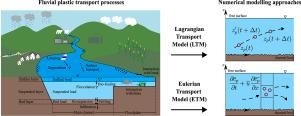Numerical plastic transport modelling in fluvial systems: Review and formulation of boundary conditions
IF 12.4
1区 环境科学与生态学
Q1 ENGINEERING, ENVIRONMENTAL
引用次数: 0
Abstract
In recent years, it has become clear that plastic pollution poses a significant threat to aquatic environments and human health. Rivers act as entry points for land-based plastic waste, while a certain fraction of entrained plastics is carried into marine environments. As such, the accurate modelling of plastic transport processes in riverine systems plays a crucial role in developing adequate remediation strategies. In this paper, we review the two main multiphase flow numerical approaches used in plastic transport modelling, comprising Lagrangian Transport Models (LTMs) and Eulerian Transport Models (ETMs). Although LTMs and ETMs can be regarded as complementary and equivalent approaches, LTMs focus on the transport trajectories of individual particles, whereas ETMs represent the behaviour of particles in terms of their mass or volume concentrations. Similar results of the two approaches are expected, while our review shows that plastic transport models are yet to be improved, specifically with respect to the formulation and implementation of boundary conditions, comprising plastic interactions with the channel bed, river bank, and the free surface, as well as interactions with biota. We anticipate that an implementation of these boundary conditions will allow for a better representation of different plastic transport modes, including bed load, suspended load, and surface load. Finally, we provide suggestions for future research directions, including a novel threshold formulation for free surface detachment of plastics, and we hope that this review will inspire the plastic research community, thereby triggering new developments in the rapidly advancing field of numerical plastic transport modelling.


河流系统的数值塑性输运模型:边界条件的回顾与表述
近年来,塑料污染对水生环境和人类健康构成了重大威胁,这一点已经变得越来越清楚。河流是陆地塑料垃圾的入口点,而一定比例的塑料被带入海洋环境。因此,河流系统中塑料运输过程的准确建模在制定适当的修复策略方面起着至关重要的作用。在本文中,我们回顾了两种主要用于塑性输运建模的多相流数值方法,包括拉格朗日输运模型(ltm)和欧拉输运模型(etm)。虽然ltm和etm可以被视为互补和等效的方法,但ltm关注的是单个粒子的输运轨迹,而etm则代表粒子在质量或体积浓度方面的行为。预计这两种方法的结果相似,而我们的回顾表明,塑料运输模型还有待改进,特别是关于边界条件的制定和实施,包括塑料与河床、河岸和自由表面的相互作用,以及与生物群的相互作用。我们预计,这些边界条件的实现将允许更好地表示不同的塑料运输模式,包括床荷载、悬浮荷载和地表荷载。最后,我们对未来的研究方向提出了建议,包括一种新的塑料自由表面剥离阈值公式,我们希望这篇综述能够启发塑料研究界,从而引发快速发展的数值塑料输运建模领域的新发展。
本文章由计算机程序翻译,如有差异,请以英文原文为准。
求助全文
约1分钟内获得全文
求助全文
来源期刊

Water Research
环境科学-工程:环境
CiteScore
20.80
自引率
9.40%
发文量
1307
审稿时长
38 days
期刊介绍:
Water Research, along with its open access companion journal Water Research X, serves as a platform for publishing original research papers covering various aspects of the science and technology related to the anthropogenic water cycle, water quality, and its management worldwide. The audience targeted by the journal comprises biologists, chemical engineers, chemists, civil engineers, environmental engineers, limnologists, and microbiologists. The scope of the journal include:
•Treatment processes for water and wastewaters (municipal, agricultural, industrial, and on-site treatment), including resource recovery and residuals management;
•Urban hydrology including sewer systems, stormwater management, and green infrastructure;
•Drinking water treatment and distribution;
•Potable and non-potable water reuse;
•Sanitation, public health, and risk assessment;
•Anaerobic digestion, solid and hazardous waste management, including source characterization and the effects and control of leachates and gaseous emissions;
•Contaminants (chemical, microbial, anthropogenic particles such as nanoparticles or microplastics) and related water quality sensing, monitoring, fate, and assessment;
•Anthropogenic impacts on inland, tidal, coastal and urban waters, focusing on surface and ground waters, and point and non-point sources of pollution;
•Environmental restoration, linked to surface water, groundwater and groundwater remediation;
•Analysis of the interfaces between sediments and water, and between water and atmosphere, focusing specifically on anthropogenic impacts;
•Mathematical modelling, systems analysis, machine learning, and beneficial use of big data related to the anthropogenic water cycle;
•Socio-economic, policy, and regulations studies.
 求助内容:
求助内容: 应助结果提醒方式:
应助结果提醒方式:


